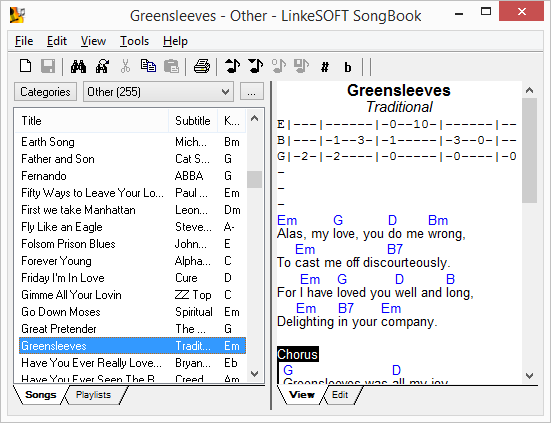 Installation And Upgrade
Installation And Upgrade
SongBook runs on all Windows PCs and laptops with Windows 11 and 10. It is optimized for use with keyboard and mouse. On Windows 10 touch tablets, consider using our Windows Store app SongBook for Windows Tablets instead.
When you run the setup, the SongBook application and all chord libraries are automatically installed. Note: Sometimes, a browser or security software might erroneously block the download or installation. If you've downloaded the software directly from our web site, it is guaranteed to be free of trojans or malware. If unsure, you can always check the downloaded setup at www.virustotal.com.
At first program start, you should select the directory where your songs will be stored. The default is <My Documents>\My Songs. You can change the song directory at any time with the "..." button next to the category dropdown. If you also use SongBook on Android or iOS, consider synchronizing your songs with Dropbox and select the Dropbox/SongBook folder as your main song directory. See this video for details.
You can find the complete version history at the end of this page.
Where To Find Songs For SongBook
SongBook understands the widespread chordpro format where chords are written in square brackets within the lyrics. Unfortunately, we cannot provide songs on this site due to copyright restrictions. However, the Internet has huge archives of songs in chordpro format, just search for the song title and chordpro.
You can also easily create your own songs. Just write the lyrics as usual and insert the chord names in square brackets at the appropriate positions as in the following example:
[Em]Alas, my [G]love, you [D]do me [Bm]wrong,
SongBook will render this as:
| Em | G | D | Bm |
| Alas, my | love, you | do me | wrong, |
You can find a detailed explanation of the chordpro format as supported by SongBook here. A sample song is available in menu Help - Sample Song.
Cloud Sync
You can synchronize your song collection across devices using Dropbox, Google Drive, Microsoft OneDrive (consumer only), or Nextcloud. Install the respective cloud sync app from their web site, then select directory SongBook (upper case S and B) in Dropbox/My Drive/OneDrive/Nextcloud as your song directory (with the "..." button next to the category dropdown). Link SongBook Android or SongBook iOS with your cloud account in Settings. See this video for details.
Song List
Songs are structured in categories. Categories are similar to folders on your computer. You can group songs in categories to help you organize them e.g. by genre or difficulty. Just like folders on your computer, deleting a category will delete all songs in it. In addition, songs can also be organized in playlists and filtered by tags.
Entering a letter will jump to the first title/subtitle starting with that letter.
You can mark songs that you've already played via the context menu (or Ctrl-Space). Marked songs are displayed in grey. Marking also applies to all playlists in which the songs appear. When you restart the SongBook application, all songs are unmarked again.
Note: you can show/hide the Song List via View - Song List.
Song View
The song view displays the current song with lyrics and chords. Click on a chord to look up the chord definitions. Chord, lyrics and tab font and color can be changed in Tools - Options - View. You can also quickly increase/decrease the font size with Ctrl +/- or Ctrl+Mouse Wheel. When you select View - Zoom - Auto-Zoom, SongBook will try to show the song as large as possible so it still fits on the screen without scrolling.
To reset the font size select View - Zoom - Normal.
Select View - All Song Chords to get an overview of all chords that appear in the current song. Initially, the most simple fingering of a chord is displayed (the one in the lowest fret). Click on a chord to cycle through all definitions.
You can switch off display of chords or lyrics with View - Hide Chords or View - Hide Lyrics, respectively.
Full Screen Mode
To make maximum use of screen real-estate, SongBook can display a song in full screen mode where the whole screen is used to display the song. Menu and toolbar will be hidden. Additionally you can hide the song list to the left with Ctrl+L.
To switch off full screen mode, type ESC.
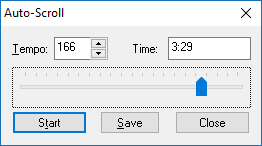 Auto-Scrolling
Auto-Scrolling
To start automatic scrolling, select on View - Auto-Scroll or press key F5 or use the Play button in the toolbar. Use the Save button in the auto-scroll popup to save the current total playing time in the song (with the {time: } directive) so it will be preset the next time you select the song.
You can optionally insert {pause: x} directives somewhere in a song, where x denotes a pause in seconds (e.g. {pause: 20} to pause for 20 seconds). When the line with this pause statement reaches the top of the screen, auto-scrolling will pause for this amount of time. You can also put that directive at the top of the song to delay the auto-scroll start.
The Windows screensaver is suppressed while the song is auto-scrolling.
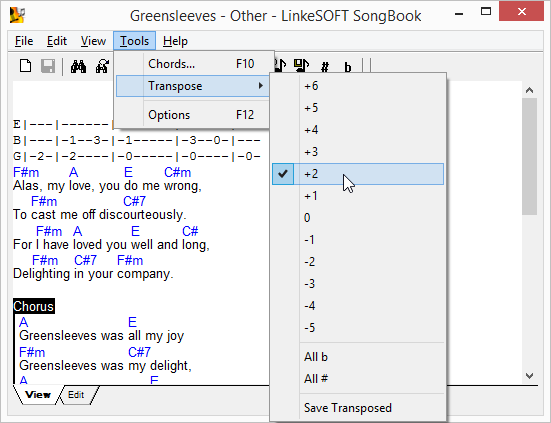 Transposing
Transposing
With menu Tools - Transpose or the transpose buttons on the toolbar, SongBook lets you transpose a song to a different key by automatically adjusting all chords. Use the "All b" and "All #" menus to convert all # chords to their b equivalent or vice versa. The transposition is only temporary. To permanently change the tune, select menu Tools - Transpose - Save Transposed.
You can use menu Tools - Transpose - Capo to define a fret for a capo. This works just like a transpose down the same number of steps, but will show a Capo: ... indicator at the beginning of the song.
The transpose menu lets you convert song chords into the Nashville Numbering System which will convert all chord names into numbers 1,2,3... This only works if a key is set in the song (with Set Key from the menu). If a song is already in Nashville Number format, you can convert it back into regular chords (again based on the defined key). Chord lookup will also work for Nashville numbers.
Note that if the song contains special chord definitions, these will usually no longer be valid after transposing.
Link With Music
If you want to play along with a music background, you can copy a music (MP3) file into the SongBook directory and link to it with menu Tools - Music - Link with music. Use Tools - Play Music to play the linked music with a built-in mini music player. Music linked this way will also play in SongBook Android, iOS or Mac OS X. Songs that have linked music are marked with a ♫ symbol in the song list.
Alternatively, you can insert a link to an arbitrary file into the song (drag the file from Explorer into the song editor), then click the link to open the associated program. This will only work on Windows, though.
PDFs
If Adobe Acrobat Reader is installed, SongBook can also display PDFs. Note that PDFs cannot be edited, tagged or transposed. Zooming, scrolling and keyboard shortcuts are limited by the Acrobat Reader control. To go out of full-screen mode while viewing a PDF, press Alt-F4.
Song Edit
You can edit songs or add new songs. The Edit - Chordpro menu lets you easily enter the most common chordpro control statements. There you can also find keyboard shortcuts for faster input. When you've selected some text, the chordpro control statement (e.g. [] or {c: }) will be inserted around the selection. If you apply [] on a line with multiple words, each of them will treated as a chord and wrapped in [].
To move a chord definition like [Am] to a different text position, double-click on it to select it, then cut/paste it at the new position.
You can easily apply chords from one verse to another with Copy Chords/Insert Chords from the context menu, see this video for details.
Use Edit - Chordpro - Convert Tab To Chordpro to convert the current song or selected text from tab format (where chords are on separate lines above the lyrics) into the compact chordpro format used by SongBook. If you select exactly two lines of text, the first line will always be treated as chords, i.e. wrapped with [] and inserted into the second line.
Tags
To further organize your song collection, you can assign arbitrary tags to any song. Klick the Tags button in the main song list screen to filter songs by tags. When you remove a tag, the song is not deleted. However, if you delete all songs that contain a certain tag, that tag will disappear from the list of tags. Unlike with categories, songs can have several tags assigned. In the song, tags are stored with a {tag: xx} directive.
Playlists (Set Lists)
Playlists are collections of songs for a special purpose, e.g. for a concert, or for practising. Playlists contain references to songs (by title/subtitle, independent of their category). You can add songs to multiple playlists, and one song can occur multiple times in one playlist. The playlist dropdown box will show the number of songs in that playlists in parentheses.
To add songs to a playlist, right-click on a song in the list and select Add to Playlist... Note: To add multiple songs at once, select them with Shift or Ctrl+Mouse-Click before you choose Add to Playlist...
To create a new playlist, right-click on a song in the song list, and select Add to Playlist... - New Playlist...
To change the order of songs in a playlist, select Move Up/Move Down from the context menu.
To remove a song from a playlist right click on the song in the playlist and select Remove...
Playlists can automatically transpose songs to different keys. To store a different key for a song in a playlist, open the song from the playlist (not from the song list), then transpose it as usual, but do not save the transposed song. If a playlist song has a different key then the original, the key will be shown inverse in the list.
Note: Playlists contain only references (title and subtitle) to the real song. If you delete the song, it is not automatically removed from the playlists.
You can add notes to playlists via the context menu, e.g. "Break" or a short story to tell between songs. These notes are displayed and edited just like normal songs, but are only stored in the playlist.
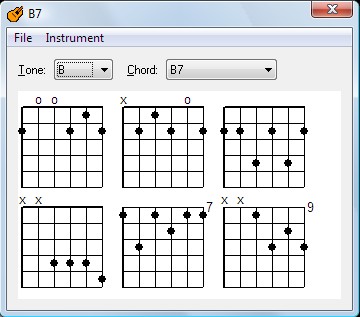 Chords and Instruments
Chords and Instruments
SongBook comes with comprehensive chord libraries for guitar, ukulele (C and D tuning), mandolin, piano and others. To see the chord view, click on a chord in a song, or select Tools - Chords...
Chords are sorted by base pitch (tone) and name. Each chord can have several variations. SongBook knows about identical pitches (e.g. C# = Db).
By default, SongBook displays the most simple variation (lowest base fret, least number of fingers) in the All Song Chords window. If you always prefer a certain variation, you can mark it as favorite. If you want a different variation for a certain song, you can define the chord variation in the song.
You can add your own chords (File - New Chord...) or change existing chord definitions by clicking on it. Own and favorite chords are saved in a file <instrument>.chords.txt in the song directory. You can edit it with a text editor. If you want your extra chords appear in the built-in SongBook chord libraries, please send us this file.
Right-click on a chord to find identical chords (with different names) or to add this specific chord definition to the song.
To remove a custom chord from the database, click on it to edit and select Remove...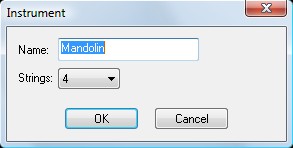
To change the currently used instrument, select it from the Instruments menu. This instrument is used for all chord lookups.
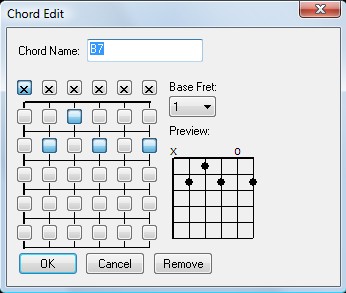 Chord Edit
Chord Edit
You can change any chord in the chord database. Select the base fret in the dropdown to the right, then click on the finger boxes. If a string does not sound (is muted), select the x above the string.
The added chords are saved in a file <instrument>.chords.txt in the documents folder. You can edit it with a text editor. If you want your extra chords appear in the built-in SongBook chord libraries, please send us this file.
License
You can try SongBook Windows before you buy it. When you continue to use SongBook after an initial trial period, you must purchase a license key. Licensed users will receive free updates and support.
Feedback
Do you have a song that is not rendered correctly? Is an important chord missing in the chord database? Please let us know.
Version History
- 5.5
- Allow whitespace in pseudo chords, e.g. [Verse 1]
- Improved tab conversion
- HTML export support for highlighting {soh} and {soh #RRGGBB}
- Option to number songs in playlists
- Fixes an auto-zoom issue - 5.4.2
- Fixes an issue with changing the category of PDFs - 5.4.1
- Option in view menu to center narrow songs
- Fix for songs with custom tuning
- Fix for issues with - Unfiled - (no) category
- Fix for an HTML export issue
- Fix for a print issue when printing in multiple columns with chords - 5.4
- Chords in song also for piano chords
- Capo popup in transpose toolbar - 5.3
- Set playing time when linking song with music
- Support user/instrument-specific images with {image-<Use>r:...}
- Support tabs in HTML export
- Smaller fixes - 5.2
- Option to print chords at top
- Mark chords as favorite (will be preferred in chord window)
- Include images when exporting as HTML
- Fix for printing songs from playlist with tranpose - 5.1.1
- Fix for print auto-zoom
- Fix: last character of file name was missing for new files and rename to song title - 5.1
- Inline images with {image: src="file.png"} file.png (or jpg) must be in the same folder as the song file
- Support {duration: ...} for total playing time (compatibility with chordpro format)
- New instrument Greek Bouzouki - 5.0
- Can export multiple selected songs as text or tab
- Can export HTML w/o chords (View - Hide Chords selected)
- Support user/instrument specific chord defines {define-Guitar: D 0 X 0 0 2 3 2} - 4.9.1
- Support user specific highlighting {soh-User}
- Fix for custom instrument/tuning
- Fix for playlist lookup - 4.9
- can show chord diagrams within the song above the lyrics
- support {artist: ...} tag (like subtitle) - 4.8.3
- don't count playlist notes in song count
- fix for some MP3s that could not be played - 4.8.2
- Link music also for PDFs
- Support *.wav files when linking music
- Improved column width handling - 4.8.1
- show playing time of selected song(s) in window title bar
- fix for notes in playlists with special characters - 4.8
- Notes in playlists
- Minor fixes - 4.7.1
- Fix printer error with some printer drivers
- Minor fixes and enhancements - 4.7
- File operations (on current category): Rename files to match song titles, Change song titles to match file names
- Remove empty lines (via editor context menu)
- New instrument Cigar Box Guitar
- Several fixes and smaller enhancements - 4.6
- Support for Nashville Number System (convert song to/from NNS, look up NNS chords) - 4.5
- Jazz Grilles with {start_of_grid}/{end_of_grid}, see also here
- New instruments Fiddle (double stops) and Mountain Dulcimer
- Several fixes - 4.4
- custom tunings
- Song-specific instrument and optional tuning via {instrument: Guitar} and {tuning: D A D G B D}
- Several smaller fixes - 4.3.2
- several fixes - 4.3.1
- support importing or dragging PDF files into SongBook - 4.3
- PDF support (requires installed Adobe Acrobat Reader)
- Support /bass chords when transposing
- Fix for songs w/o subtitle in playlists - 4.2.2
- Focus on song when hiding song list
- Improvements for printing piano chords - 4.2.1
- small fixes - 4.2
- Improved auto-scrolling
- New instrument Ronroco
- Import/Export color/font settings - 4.1.2
- fix potention crash immediately after a fresh installation - 4.1.1
- Auto-zoom fix
- Secondary sorting (title/subtitle) - 4.1
- Keys in playlists: open the song from a playlist and transpose it without saving - 4.0.2
- Support {new_page} for page breaks when printing
- Keep editor cursor position when saving
- Use / in {musicpath: ...} for compatibility with other platforms
- Use standard size for chord diagrams independent of chord font size - 4.0.1
- small fixes - 4.0
- Use time instead of tempo for calculating auto-scroll speed (compatible with SongBook for iOS, Android, Windows Tablet etc)
- Show total playing time of playlist (if all songs have a {time: ...} directive)
- Option to ignore A/The in title/subtitle when sorting
- Show unfiled songs (songs without category)
- Fix formatting of lines that only contain chords
- Option Chorus: shading will no longer be applied to printouts because of a Windows bug - 3.9.1
- small fixes - 3.9
- User-specific directives for comments, capo, instrument, so you can have one song file with different instructions for guitar/bass, or lead/background:
{comment-<user>:...}, {capo-<user>: ...}, {instrument-<user>: ...}
User specific directives will only be active if <user> is set as current user in Tools - Options.
- Important fix that could lead to crashes
- Several smaller fixes - 3.8
- Print option to print in black and white
- Improved color selection dialog
- Mark songs that have linked music with ♫
- Smaller fixes - 3.7.1
- use black text in printouts if text color is white - 3.7
- New icon
- Drag songs from playlists into e.g. mail to send as attachments
- Play/Pause button for auto-scroll on toolbar
- Support {pause: ...} for auto-scrolling
- Smaller fixes - 3.6.2
- Sort playlists by title/subtitle/key (via context menu)
- Show current position/total time in Play Music popup
- Smaller fixes - 3.6.1
- Show songs without tags
- Navigate through song list with ctrl-page up/down even when editor is open
- Fix for printing songs with capo setting
- Fix for selecting wrong song when changing playlists
- Smaller fixes - 3.6
- More print options: multi-column, auto-zoom, number of chords per row - 3.5.4
- Fix: Link with music did not always save path to music file - 3.5.3
- Fix playing/linking music for playlist songs - 3.5.2
- Support one-finger scrolling on touch tablets
- bigger toolbar on high-res screens
- Smaller fixes - 3.5.1
- fix for using Space and Backspace keys in popups - 3.5
- Support {musicpath: ...} for playing music files in local SongBook directory
- Menu Tools - Music Link with music and mini music player
- Menu View - Inline Chords will inline chords with lyrics for a compact display
- Reverse zoom direction for Ctrl + Mouse-Wheel to be more consistent with other apps
- Handle zoom in song view and editor independently
- Can now choose between centered/left aligned title/subtitle (menu View - Center Title)
- Can also use Space and Backspace to move to next/previous song
- Option to switch off automatic refresh of song list (use in case of random flickering or crashes)
- Smaller fixes - 3.4.4
- Chord look up uses canonical chord names (recognizes D# as Eb)
- Smaller fixes - 3.4.3
- Reset Options
- Several smaller fixes - 3.4.2
- Mark chorus ({soc}..{eoc}) options: bar, indent or shade
- New instrument 5 string bass (Bass_5)
- Several fixes - 3.4.1
- Use Edit - Chordpro - [chord] on selected text with several words will chordify each word
(useful for converting tab lines that only contain chords)
- Use Edit - Chordpro - Convert Tab to Chordpro on a selection with exactly two lines will always treat the first line as chords
(useful for converting lines that the full conversion didn't recognize as chords)
- Fix: lost list focus when selecting different song
- Several other fixes - 3.4
- Support {capo:...} for setting capodaster (negative transpose)
- Copy Chords/Insert Chords via context menu in editor for selected text
- Use highlight font from options for {soh}...{eoh}
- Fix when switching to different song without saving current song - 3.3.2
- Can open links relative to current SongBook directory, e.g. file://test.pdf
- Playlists in sub directories are now included (useful when sharing a sub folder via Dropbox)
- Small fixes - 3.3.1
- Can transpose selection in editor
- Small fixes - 3.3
- Show key also for playlist songs
- Can drag files from songs (category/tag) list, e.g. into a mail
- Option to set list font/size
- Hide menu and toolbar on fullscreen mode (restore with ESC)
- Quickly insert chords used in the current song via context menu in song editor - 3.2.1
- Fix for random crashes
- Improved auto-zoom performance
- Re-enabled installation on Windows XP (but unsupported) - 3.2
- Instrument Piano
- Several fixes - 3.1
- Rename Playlist, Duplicate playlist
- Tags and add to playlists menu in playlist view
- higlight in custom colors with e.g. {soh #xxxxxx} (hex web colors)
- Fix for flickering when auto-scrolling
- Fix for creating new instruments
- Minor fixes - 3.0
- Transpose to all b or all #
- Drag/drop files from Explorer into the editor to create file:// links
- Tag support
- Minor fixes - 2.9.1
Several small fixes - 2.9
More color options
Support highlighting with {soh}..{eoh}
Minor fixes - 2.8.5
- Keep focus on song list when switching songs
- Minor fixes - 2.8.4
- Show key in song list (set via {key: xx} or first chord in song)
- Fix: unknown control directives correctly ignored
- Fix: auto-scroll tempo was not correctly updated in song - 2.8.3
- fix number of string for Banjo chords - 2.8.2
- various fixes - 2.8.1
- added back support for Win XP
- use arrow keys in song view to scroll single line - 2.8
- Enharmonic transposition
- Save button to save auto-scroll tempo in song
- New icon
- More instruments
- Several fixes - 2.7
- Links in songs (e.g. www.linkesoft.com or file://c:\path\to\song.mp3)
- Minor fixes - 2.6
- Load and save custom chords to a <instrument>.chords.text file in song directory, compatible with the iOS and Android versions. Note: does not apply to chords entered with older versions of SongBook Windows
- Support all kinds of line endings (Windows, Mac, Unix)
- Fix display of chords in higher frets with empty strings
- Fix: printing chords at bottom of song was broken
- Minor fixes - 2.5
- Page Up/Down also moves to previous/next song (to support hands-free page turning with e.g. AirTurn)
- Copy song lists e.g. for printing lists of songs/playlists via Word
- Fixes for reading large songs - 2.4.2
- Changing title/subtitle of a song will update all playlists that contain this song (like in SongBook iPhone)
- Songs with special characters will be saved in UTF-8 instead of UTF-16
- Fixes for playlists with Unicode characters - 2.4.1
- fix for crashes/odd characters in 16bit Unicode files - 2.4
- Option to print all chords for a song
- UTF-8 support for compatibility with SongBook iPhone
- Minor fixes - 2.3
- Drag-drop songs onto SongBook to import (and convert if necessary)
- HTML export rewritten
- HTML export for multiple files at once
- Option to show chords at the bottom of HTML pages
- Import bug fix that may have led to overwritten songs or crashes
- Correct handling of print margin settigns (in % of page size)
- Other minor fixes - 2.2
- Export in tab and txt format
- Print multiple selected songs
- Change font size for editing (similar to font size change for song view)
- Context menu for changing category of selected song(s)
- Bug fixes - 2.1
- Apply transpose only to selection (in Edit mode)
- Remove songs/playlists to recycle bin
- Drag-and-drop text inside song edit field
- Drag-and-drop in playlists
- Sort by date (via menu)
- Minor improvements to Auto-Scroll popup
- Bug fixes - 2.0
- Unicode support (songs in other character sets, e.g. Cyrillic or Chinese)
- Auto-zoom (show song as large as possible w/o scrolling)
- HTML export
- Toolbar buttons and shortcuts for easy transposing songs (change tune of song)
- When adding songs to playlists, mark playlists that already contain this song with check mark (but you can still add it a second time)
- Starting SongBook with a directory or a file as parameter will open that directory or file, resp.
- In Song edit mode, double click selects the [chord] for easier cut/paste
- Bug fixes - 1.3
- Ability to show/hide chords/lyrics
- Screensaver is suppressed while auto-scrolling is active
- Option to suppress screensaver while SongBook is running
- Bug fixes - 1.2
- Show song in multiple columns if it fits on screen
- Keyboard shortcuts for inserting chordpro controls
- Mark played songs with context menu (or Ctrl-Space)
- Show song count per category/playlist
- Chord overview of all chords used in song
- Convert tab to chordpro via Edit menu (for whole song or selection only) - 1.1
- Option to print locally defined chords at bottom of song page
- Context menu in chord view to find identical chords, or to insert chord definition into current song
- Highlight search result in song view
- Bug fixes - 1.0
- First public version for Windows, feature set identical to Palm and Pocket PC versions
Special thanks to Kenny Song and Laurence Esterhuizen for their work on the chord databases and numerous valuable suggestions.
